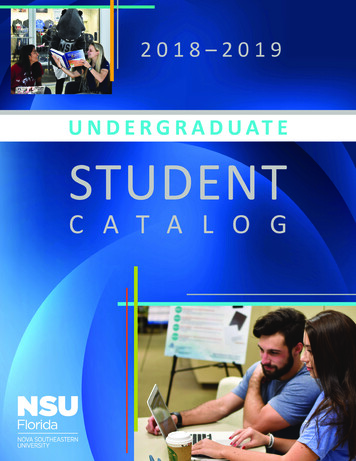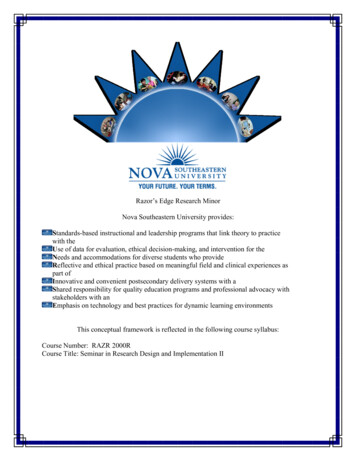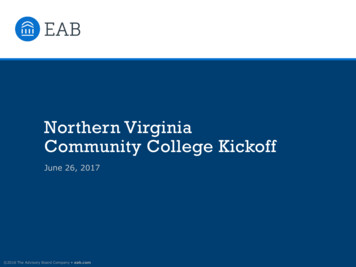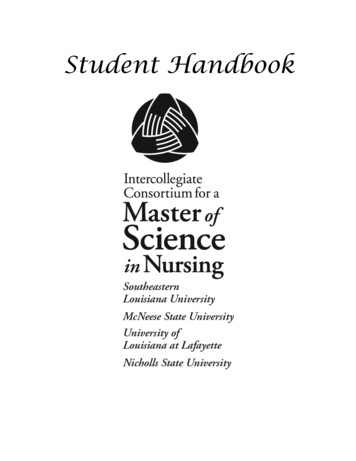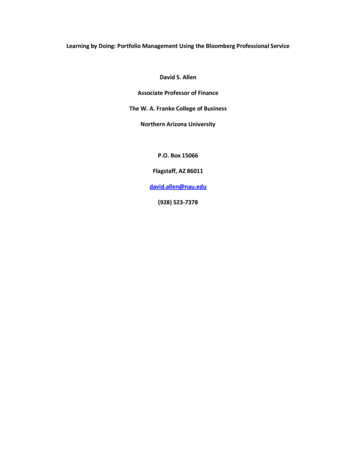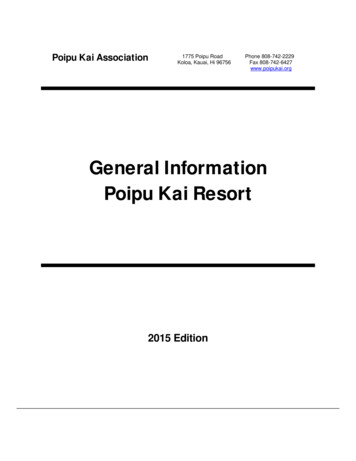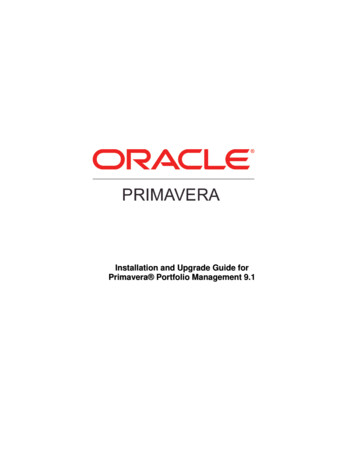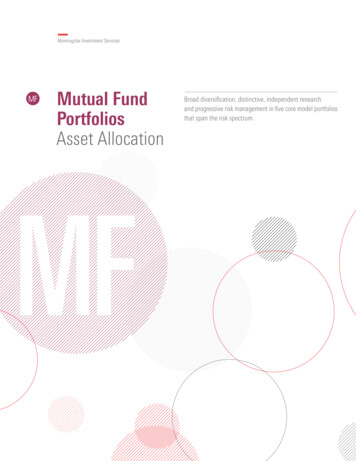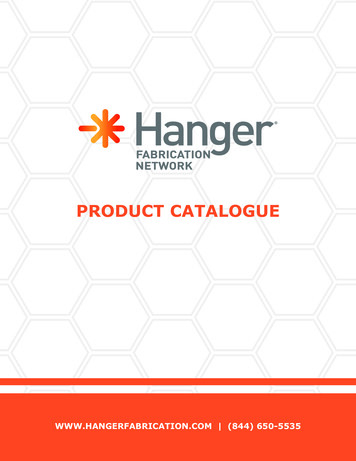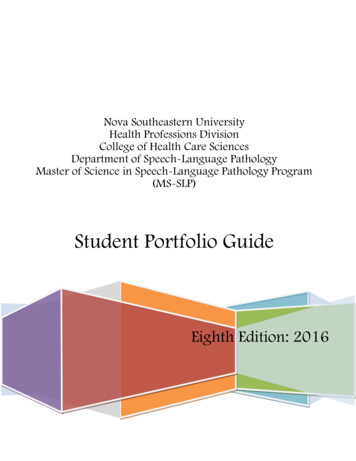
Transcription
Nova Southeastern UniversityHealth Professions DivisionCollege of Health Care SciencesDepartment of Speech-Language PathologyMaster of Science in Speech-Language Pathology Program(MS-SLP)Student Portfolio GuideEighth Edition: 2016
A Message to the Student about the PortfolioThe Student Portfolio Guide is to be used as a reference throughout the portfolio process. Itspurpose is to assist you in developing your unique portfolio in order to demonstrate theknowledge, skills, and competencies which you will acquire during your enrollment in the Masterof Science in Speech-Language Pathology program (MS-SLP) at Nova Southeastern University(NSU).To assist you in creating your portfolio, the NSU chapter of the National Student SpeechLanguage Hearing Association (NSSLHA) has organized and assembled individual StudentPortfolio notebooks available for you to purchase. Each pre-assembled notebook meets thecriteria for creating a portfolio as described in this Guide and includes sample forms. If you wishto purchase a NSSLHA Student Portfolio notebook, contact Ms. Brenda Miles, Program Manager(bmiles@nova.edu). Proceeds of the sale of the notebooks cover the cost of supplies and any extrafunds go to the local NSSLHA chapter.Please read the contents of the Portfolio Guide carefully. If there are questions or concerns, pleasecontact Mr. Steven Vertz, Associate Director and Acting Formative Assessment Coordinator:(svertz@nova.edu).Good luck as you begin this exciting and challenging project!Steven P. Vertz, M.S., CCC-SLPActing Formative Assessment CoordinatorAssociate Director and InstructorMaster of Science in Speech-Language Pathology (MS-SLP) programDepartment of Speech-Language PathologyCollege of Health Care SciencesHealth Professions DivisionNova Southeastern University2
AcknowledgementsThe Nova Southeastern University Graduate Teacher Education Program Student Portfolio Guide, authored byVesna Beck, Ed. D. (December, 2000) served as the primary source for this document.The adaptation and use of this Guide will provide and promote consistency across intra-university trainingprograms.The program recognizes the effort and dedication of Crystal Cooper, M.S., CCC-SLP inher creation and ongoing development of the Master of Science in Speech-LanguagePathology program portfolio.3
Table of ContentsIntroduction . 5Chapter 1.Frequently Asked Questions (FAQs) About the Student Portfolio . . 6Chapter 2.The Portfolio Evidence . . . . . 12Chapter 3.Creating a Portfolio . . . 17Chapter 4.The Portfolio Format . . . . 19References . . . . 24Appendix ABenchmarks of Florida Educator Accomplished Practices . . . 26Appendix B Definitions and Examples of Evidence for Individual Florida EducatorAccomplished Practices . . . 29Appendix CAmerican Speech-Language-Hearing Association Standards for theCertificate of Clinical Competence in Speech-Language Pathology. . . 64Appendix DImplementation Procedures and Examples of Evidence for ASHA Standardsfor Certificate of Clinical Competence . . . . . 68Appendix EProgram Outcomes and Definitions for the Program in Speech-LanguagePathology . . 92.Appendix F Criteria for Evaluation of Evidence . . . 99Appendix GForms Used in Student Portfolio Process . . . . . 103Appendix HThe Code of Ethics and The Principles of Professional Conduct of theEducation Profession in Florida . . . . . 124Appendix I The Code of Ethics of the American Speech-Language-Hearing Association(2016) . 1284
IntroductionThe purpose of this portfolio is to provide an organized approach through which the student will demonstratecumulative knowledge and professional skills acquired during the student’s coursework and clinical experienceswhile enrolled in the Master of Science in Speech-Language Pathology (MS-SLP) program at Nova SoutheasternUniversity (NSU).The contents of the portfolio are adapted from the NSU Graduate Teacher Education Program Student PortfolioGuide, which is based upon the “Accomplished Preprofessional and Professional Competencies for Teachers ofthe 21st Century” (also referred to as “Florida Educator Accomplished Practices”) as described by the FloridaState Department of Education. The Florida Educator Accomplished Practices address 6 key elements andbehaviors considered necessary to become an effective speech-language pathologist.The student portfolio serves several purposes:1. The portfolio is an authentic method of assessing educational outcomes.2. The portfolio is a comprehensive means of assessing Florida Educator Accomplished Practices attainedby the student during the program.3. The portfolio documents the student’s best practices and products.4. The process allows for the active participation of the student in the assessment of learning.5. The portfolio may be used by the student for job interviews and for other professional endeavors.In addition to specific benefits to the students, the entire portfolio process enhances the Master of Science inSpeech-Language Pathology (MS-SLP) program curriculum by ensuring that the courses are current, relevant,and responsive to state requirements as well as to current trends in education and national standards in speechlanguage pathology. The student portfolio requirement reflects the commitment of NSU’s Master of Science inSpeech-Language Pathology (MS-SLP) program to Florida state guidelines and to authentic, formativeassessment of academic and clinical skills needed by students to meet national certification standards in speechlanguage pathology as set forth by the American Speech-Language-Hearing Association (ASHA) as well asaccreditation standards mandated by the Council on Academic Accreditation (CAA) of Audiologists and SpeechLanguage Pathologists of ASHA.The portfolio provides a tangible link between subject areas within the SLP curriculum, thereby strengthening theknowledge and skills content of the SLP curriculum and fostering partnerships between faculty members to ensurequality education to students enrolled in the MS-SLP.5
Chapter 1Frequently Asked Questions (FAQs)About the Student PortfolioWhat is the SLP Student Portfolio?The SLP Student Portfolio is a formative assessment tool used to encourage professional development andreflective learning. It is a selective form of authentic assessment which appears to be well-suited for evaluatingthe application of theory into practice. The portfolio contains a collection of evidence, also called artifacts, of thestudent’s learning outcomes attained throughout the graduate program, indicating an acquisition and mastery ofprofessional clinical skills as well as achievement of Florida Educator Accomplished Practices and Standards forClinical Certification. The ownership of and responsibility for the portfolio is the student’s. The portfoliois the property of the student, and it is the student’s responsibility to ensure that the evidence presented isin accordance with the procedures stated in this Guide.The framework of the portfolio is based on the 6 Florida State Department of Education Florida EducatorAccomplished Practices for Educators (FEAPs) that contain professional benchmarks of competency (AppendixA) and selected Standards required for obtaining the Certificate of Clinical Competence (CCC) from ASHA(Appendix C). Each category contains sample key indicators. Examples of portfolio evidence are presented foreach practice and standard. These samples provide an approved list of activities from which the student maychoose in order to demonstrate the achievement of a given practice (Appendices B and D).Who must develop the Portfolio?All students enrolled in the NSU MS-SLP must complete a portfolio as a requirement for graduation.What category of Florida Educator Accomplished Practices Benchmarks is applicable tothe MS-SLP student?The “Pre-professional” level of benchmarks is the category which applies to students enrolled in the MS-SLP.What should be included in the Student Portfolio?Specific assignments and activities designated in each SLP course syllabus are listed in a Portfolio Evidence Tablefor SLP Course Assignments to address the portfolio requirements. Evidence is to be selected from the student’sbest work. Requirements for the development of the portfolio are presented in Chapter 4 of this Guide. For furtherclarification, or to answer your questions regarding evidence related to a specific course or clinical experience,6
contact the course instructor or clinical supervisor. For general questions regarding the portfolio process, contactthe Acting SLP Formative Assessment Coordinator, Mr. Steven Vertz (svertz@nova.edu).How many pieces of evidence are required for each Florida Educator AccomplishedPractice, each ASHA Standard, and each Program Outcome?A minimum of two (2) pieces of evidence is required for each Florida Educator Accomplished Practice. One (1)piece of evidence is required for each ASHA Standard and one (1) for each Program Outcome.Can the same piece of evidence be used more than once?The student may create evidence that demonstrates mastery of more than one Florida Educator AccomplishedPractice as well as one ASHA CFCC Standard and one Program Outcome. However, each piece of evidence maynot be used for more than two (1) Florida Educator Accomplished Practices, one (1) ASHA Standard, and one(1) Outcome.When should the student begin to develop a portfolio?The student should begin to develop a portfolio and collect evidence at the beginning of the student’s graduatecourse work. (Helpful Hint: Throughout the graduate program enrollment, maintain a clearly marked folder inwhich to keep all prospective evidence/artifacts. When it is time to enter evidence into the portfolio, all of thedocuments will be in one place for easy access.)Can evidence from prerequisite coursework be included in the portfolio?Evidence from prerequisite coursework cannot be included in the portfolio.Can a student use evidence obtained during enrollment in a course at another university?No. If a student enrolls in a graduate course at another university, evidence or artifacts developed for that coursecannot be included in the student’s portfolio, even if the course grade has been deemed acceptable for transfer.The course instructor from the other institution may not sign the ECR Form.Must a student redo Evaluation Classification and Reflection (ECR) Forms and have theforms resigned if the form itself is revised during the student’s enrollment?No. In most instances, revisions are not retroactive and the student need not redo already completed ECR Forms.How is the portfolio evaluated?Appendix F includes specific criteria for evaluating portfolio evidence and artifacts. In order to create a welldocumented, accurate portfolio, it is critical to be familiar with the standards and the forms used to evaluate yourportfolio materials (see Appendix G).7
Evaluation of the evidence created for the portfolio is an ongoing process throughout the MS-SLP. Facultymembers and supervisors will evaluate the student’s evidence dependent upon the course and/or the clinicassignment. Student Portfolio Evaluators (site visitors) will evaluate the portfolio at three benchmark checkpointsthroughout the program.During enrollment in the first clinical practicum, an initial portfolio review is conducted by an assigneddepartmental Student Portfolio Evaluator to ensure that the student understands the process and to provideguidance for further portfolio development.As needed, a Portfolio Action Plan (PAP) is developed to address areas of deficiency to assist the student inworking toward the successful completion of the portfolio. The PAP is developed by the student and the PortfolioEvaluator. Follow-up activities and timelines are determined in writing at the meeting.An interim portfolio evaluation is conducted midway through the student’s graduate program, during the student’sfirst externship site visit. At that time, the portfolio is reviewed and completed by the Student Portfolio Evaluator.Any problems or portfolio deficiencies are discussed with the student.At the end of the program, during the student’s second externship site visit, a final portfolio evaluation isconducted, during which the completed portfolio and the two required Reflection Essays are reviewed by thePortfolio Evaluator. The completed FPE form is then submitted by the student to the Formative AssessmentCoordinator (or his/her designee).After reviewing the documents, the Formative Assessment Coordinator (or his/her designee) completes thePortfolio Exit Checklist (PEC) and assigns a portfolio project grade of “Pass” or “Fail.” The student is requiredto receive a portfolio grade of PASS in order to graduate from the MS-SLP.Does the portfolio count toward a course grade?Specific individual course assignments are designated as portfolio assignments, and they count toward the coursegrade. However, the portfolio is graded independent of course assignments. An independent portfolio grade of“Pass” or “Fail” will be assigned at the end of the MS-SLP when the completed portfolio is submitted for finalevaluation and approval. The portfolio grade will not be computed into the student’s cumulative grade pointaverage; however, a grade of “Pass” on the portfolio will be required for graduation.Is the original copy of an assignment, which may include errors plus comments andsuggestions from the instructor, be used as evidence or is a corrected revision of theassignment to be used?The original copy of the assignment, with comments from the instructor, is to be used as evidence. The studentmay choose to include both the original copy and the corrected, revised version as evidence. Including both theoriginal and the revised versions may demonstrate the student’s ability to accept suggestions and to makeappropriate changes. If the original document is not available to print, then a ‘clean’ copy would suffice, giventhat the instructor signs the ECR.8
Is the ECR form submitted to the instructor with every assignment or project listed in thecourse syllabus as an example of evidence for the portfolio?No. The student has a choice of whether or not to include an assignment in the portfolio. After the student hasselected an assignment or project to be used as evidence in the portfolio, the completed ECR form, with theassignment attached, is submitted to the instructor or supervisor. It is strongly suggested that the ECR form is tobe submitted to the instructor at the end of the semester during which the course is taken.Can testimonies or letters of recommendation written before entry into the MS-SLP at NSUbe used as portfolio evidence?No. Only evidence obtained or developed during enrollment in the MS-SLP at NSU may be used as evidence forthe portfolio.Can the same artifact be used as evidence for a Florida Educator Accomplished Practice inaddition to an ASHA Standard and a Program Outcome?Yes. If one artifact demonstrates achievement of a Florida Educator Accomplished Practice, an ASHA Standard,and a Program Outcome, that one artifact may be used as evidence for all three categories.Can clinical artifacts regarding adult clients as well as pediatric clients be used as portfolioevidence?Yes. In accordance with ASHA Standards guidelines and Program Outcomes, evidence may be pertinent to eithera pediatric or an adult client. Florida State Department of Education Florida Educator Accomplished Practices forEducators evidence must relate to school-aged children.What happens if a student receives a grade of “Fail” on the final portfolio?If a student receives a grade of “Fail” on the final portfolio submitted, the student cannot graduate from the MSSLP. The portfolio is reviewed by the Formative Assessment Coordinator (or his/her designee), and suggestionsare made regarding the deficiencies and/or inaccuracies. The student must submit the revised portfolio within4 weeks of the review for further evaluation. Only when a portfolio grade of “Pass” is earned, may a studentgraduate from the MS-SLP. The student has the right to appeal the grade and may follow the departmentalguidelines for the appeals process. (See SLP Orientation Booklet).How may the student benefit from the development of the portfolio?The portfolio may be viewed as a foundation for the professional development of the student. According to James& Van Cleaf (1990), portfolios serve the following purposes: Students are more realistically oriented to professional requirements.Performance areas for continuing professional development are identified.Students are provided with immediate short- and long-term goals and projects.The interrelationship between academic coursework and guided field experiences9
is made more apparent.There are other practical applications and uses of the portfolio. For example: The student may take the portfolio to a job interview to demonstrate how the student applies theoreticalconcepts and academic knowledge to practical clinical experiences. In some states, candidates for professional licensure may be required to submit a professional portfolio. The portfolio demonstrates the student’s progress in the achievement of the 6 Florida EducatorAccomplished Practices required by the State of Florida Department of Education. The portfolio is a formative assessment tool to demonstrate achievement of the knowledge and skillcompetencies relative to the American Speech-Language-Hearing Association Standards for theCertificate of Clinical Competence. The portfolio authenticates achievement of MS-SLP Outcomes for Learning.10
Chapter 2The Portfolio EvidenceTypes of EvidenceSeven categories of evidence have been determined to be appropriate to demonstrate achievement of selectedFlorida Educator Accomplished Practices, ASHA Standards, and Program Outcomes. These categories may beused as guidelines for collecting artifacts for the SLP Student Portfolio. The student is not required to use allseven categories of evidence in the portfolio. Performances: Performance activities may involve role-playing or demonstrations of clinical skills inpracticum or externships. Students actually “perform” to demonstrate mastery of a benchmark. Theactivities may be videotaped or audio taped for review and evaluation. (Note: Signed permission must beobtained in order for any client videotape, audiotape, or photo to be included in the portfolio. All photosor videotapes must be de-identified before it may be included in the portfolio. For details, see Statementof Privacy and Confidentiality form (Appendix G). Products: Products are documents and artifacts that are created, usually in written form, to demonstratestudent understanding of or reaction to a particular situation or a specific issue. Some examples ofproducts are: lesson plans, progress reports, and evaluations. Clinical Outcomes: Clinical outcomes are the results of clinical progress achieved by the graduatestudent’s clients as a result of treatment related to a specific Florida Educator Accomplished Practice,ASHA Standard, or Program Outcome. Testimonials: Testimonials are documented evidence of what others have said about the student and thestudent’s professional performance. Informal notes, letters of recommendation, letters of appreciation, andawards are the most common examples in this category. The testimonials must address specificcompetencies described in the Florida Educator Accomplished Practices, ASHA Standards, or ProgramOutcomes. Tests and Records: Tests and records are the actual scores, tests, and records of the student’sperformance in the SLP program. Grades, transcripts, letters from the Department of Education reportingthe results of the teacher certification exam and/or the Educational Testing Service notification of resultsof the national Praxis exam in speech-language pathology are included in this category of evidence. Ifused as evidence, the tests and records must clearly indicate the relationship to a specific Florida EducatorAccomplished Practice, Standard, or Outcome. Professional Values and Commitments: Professional values and commitments are evidences indicatingwhat the student perceives to be important to the emerging and practicing professional. These evidencesmay include documentation of participation in professional organizations, documented attendance atprofessional conferences or workshops, evidence of subscriptions to professional journals, or abstracts ofprofessional literature read by the student.11
As the student progresses though the program, evidence will be graded by SLP faculty members and supervisors.Each piece of evidence will be graded using the criteria and forms which appear in the Appendices. It isrecommended that the student become familiar with those criteria and forms in order to facilitate the creation ofappropriate pieces of evidence.Required Amount of Evidence for Each CourseIn each course syllabus within the SLP program curriculum, there will be assignments designated as approvedevidence for inclusion in the portfolio. Course assignments chosen by the student for inclusion in the portfoliomust be evaluated and graded by the SLP course instructor or clinical supervisor.For each Florida Educator Accomplished Practice, the student may select a minimum of two of the courseassignments designated in the Portfolio Evidence Table for SLP Course Assignments presented with each coursesyllabus (Appendix G) throughout the program. A minimum of one designated course assignment from the tablemay be selected for use as evidence for each Standard and one for each Program Outcome.General requirements for the portfolio are listed at the end of Chapter 4 of this Guide. Each student is advised tocheck with a designated SLP Student Portfolio Evaluator or the Formative Assessment Coordinator to ensure thatall portfolio requirements have been met.Evaluators of EvidenceBecause of the dynamic nature of the portfolio, it is necessary for several professionals to evaluate the studentportfolio over the period of time during which the student is enrolled in the SLP program. Evaluators will include:SLP faculty members, clinical practicum supervisors, externship supervisors, and the Formative AssessmentCoordinator. The evaluators will use the forms provided in Appendix G to verify the student’s work.Designated SLP course instructors and clinical supervisors will review and sign the Evidence Classification andReflection Form -ECR (Appendix G). The ECR is to be used when evidence is evaluated for various classes andclinics throughout the student’s enrollment in the program. Each ECR Form reflects the attainment of a specificFlorida Educator Accomplished Practice or Standard as well as the Program Outcome for the Programs in SpeechLanguage Pathology (Appendices A, C, E).The designated SLP Student Portfolio Evaluators/Site Visitors will be responsible for the initial, interim, andfinal portfolio reviews using the Portfolio Evaluation Form:The initial portfolio review is presented by the student to the Student Portfolio Evaluator during enrollment in thefirst clinical practicum. The purpose of the feedback offered at the time of the review is to provide appropriatedirection to the student and to build a foundation to assist the student in the further development of the portfolio.The interim portfolio evaluation form is to be used midway through the SLP program, during the first externshipexperience, to ensure that the student is “on the right track” in the portfolio process. At the time of the interimevaluation, the evaluator will provide critical feedback to the student regarding what has been done up to thatpoint and what needs to be done to ensure successful and timely completion of the portfolio.12
The final portfolio evaluation form is to be completed and signed by the evaluator when all portfolio requirementshave been met. The student is responsible for submitting the completed and signed FPE to the FormativeAssessment Coordinator.The Portfolio Exit Checklist – PEC (Appendix G) is the final documentation in the portfolio process. The PEC iscompleted and signed by the Formative Assessment Coordinator after verification that all portfolio requirementshave been met. The PEC form is sent to the Graduate Academic Advisor for graduation processing.It is the student’s responsibility to ensure that the entire content of the portfolio, including all evidence andforms, are completed accurately and in a timely manner.Minimum requirements for the Initial Portfolio Presentation Review, conducted during student enrollment inClinic I and the minimum requirements for the Interim Portfolio Evaluation, conducted during student enrollmentin the first externship are listed on the following two pages.13
Minimum Requirements for the Initial Portfolio ReviewDevelopment and refinement of portfolio procedures are part of an ongoing process. In order to assist students inthe initiation of the portfolio, new requirements for the Initial Portfolio Review were implemented beginning inthe Fall 2006 semester.By the first portfolio review (IPPR) meeting, which takes place during Clinic I., students must have a minimum ofthe following documents completed and included in their portfolio:1. A portfolio notebook, assembled and organized according to guidelines specified in the SLP StudentPortfolio Guide (viewed on the SLP program website: http://healthsciences.nova.edu/slp/ click“Handbooks and Manuals”)2. Students are encouraged to consider purchasing the pre-assembled NSSLHA portfolio notebook. Forfurther information regarding the purchase of the notebook, please contact Ms. Brenda Miles, ProgramManager at bmiles@nova.edu3. Signed Statement of Privacy and Confidentiality4. Statement of Purpose (adapted from sample Statement found in SLP Student Portfolio Guide or in the preassembled NSSLHA portfolio)5. Statement of why the student chose to enter the field of speech-language pathology (the statement shouldbe no longer than one page).6. A minimum of three (3) completed, faculty-reviewed and signed Evidence Classification and Review(ECR) forms.If a student does not comply with these above-stated requirements, the student will receive a written “professionalwarning.” Should the student receive two (2) professional warnings during the course of enrollment in the SLPprogram, the student will be placed on professional probation.As always, if you have any questions about the portfolio process, contact Mr. Vertz at svertz@nova.edu . Thankyou for your cooperation.14
Minimum Requirements for the Interim Portfolio ReviewDevelopment and refinement of portfolio procedures are part of an ongoing process. In order to assist students inkeeping up with their portfolios in a timely manner, new requirements for the Interim Portfolio Review wereimplemented beginning in the Summer 2007 semester.By the second portfolio review (IPE) meeting, which takes place during Externship 1, students must have aminimum of the following documents completed and included in their portfolio:1. A portfolio notebook, assembled and organized according to guidelines specified in the MS-SLP StudentPortfolio Guide (viewed on the SLP program website: healthsciences.nova.edu/slp/ click “Handbooksand Manuals”) A pre-assembled notebook may be purchased from our local NSSLHA chapter. ContactMs. Brenda Miles, Program Manager, at (bmiles@nova.edu)2. Cover Page3. Signed Statement of Privacy and Confidentiality4. Statement of Purpose (adapted from sample Statement found in Student Portfolio Guide or in the preassembled NSSLHA portfolio)5. Statement of why the student chose to enter the field of speech-language pathology. (The statement shouldbe no longer than one page.)6. Professional Resume7. Future Professional Goals8. A minimum of ten (10) completed, faculty-reviewed and signed Evidence Classification and Review(ECR) forms.If a student does not comply with these above-stated requirements, the student will receive a written “professionalwarning.” Should the student receive two (2) professional warnings during the course of enrollment in the SLPprogram, the student will be placed on professional probation.As always, if you have any questions about the portfolio process, contact Mr. Vertz at svertz@nova.edu . Thankyou for your cooperation.15
Chapter 3Creating a PortfolioDeveloping a portfolio is a step-by-step, dynamic process which spans the entire period of enrollment in the SLPgraduate program. Each student enrolled in the MS-SLP is responsible for the following:Step 1. – Learn the Portfolio ProcessIn order to become familiar with the material needed for inclusion in the portfolio, it is recommended that thestudent carefully read the SLP Student Portfolio Guide upon enrollment in the SLP program. The portfolioprocedures and guidelines are to be followed as specified in the Guide. If there are any questions or concerns, thestudent is advised to contact the SLP Formative Assessment Coordinator or a designated SLP Student PortfolioEvaluator.Step 2. – Maintain the Artifacts (Evidence)It is advisable to maintain a notebook and to develop a simple filing system for the forms, journals, reports, andother materials selected as evidence. Storing the information on a computer is recommended. Students are advisedto retain copies of all documents until the final portfolio is graded and approval for graduation has been granted.Step 3. – Determine the Portfolio Requirements for Each Course TakenEach graduate course syllabus contains a Portfolio Evidence Table for SLP Course Assignments identifyingassignments and/or activities which may be used as evidence. Specific Flori
3 Acknowledgements The Nova Southeastern University Graduate Teacher Education Program Student Portfolio Guide, authored by Vesna Beck, Ed. D. (December, 2000) served as the primary source for this document. The adaptation and use of this Guide will provide
